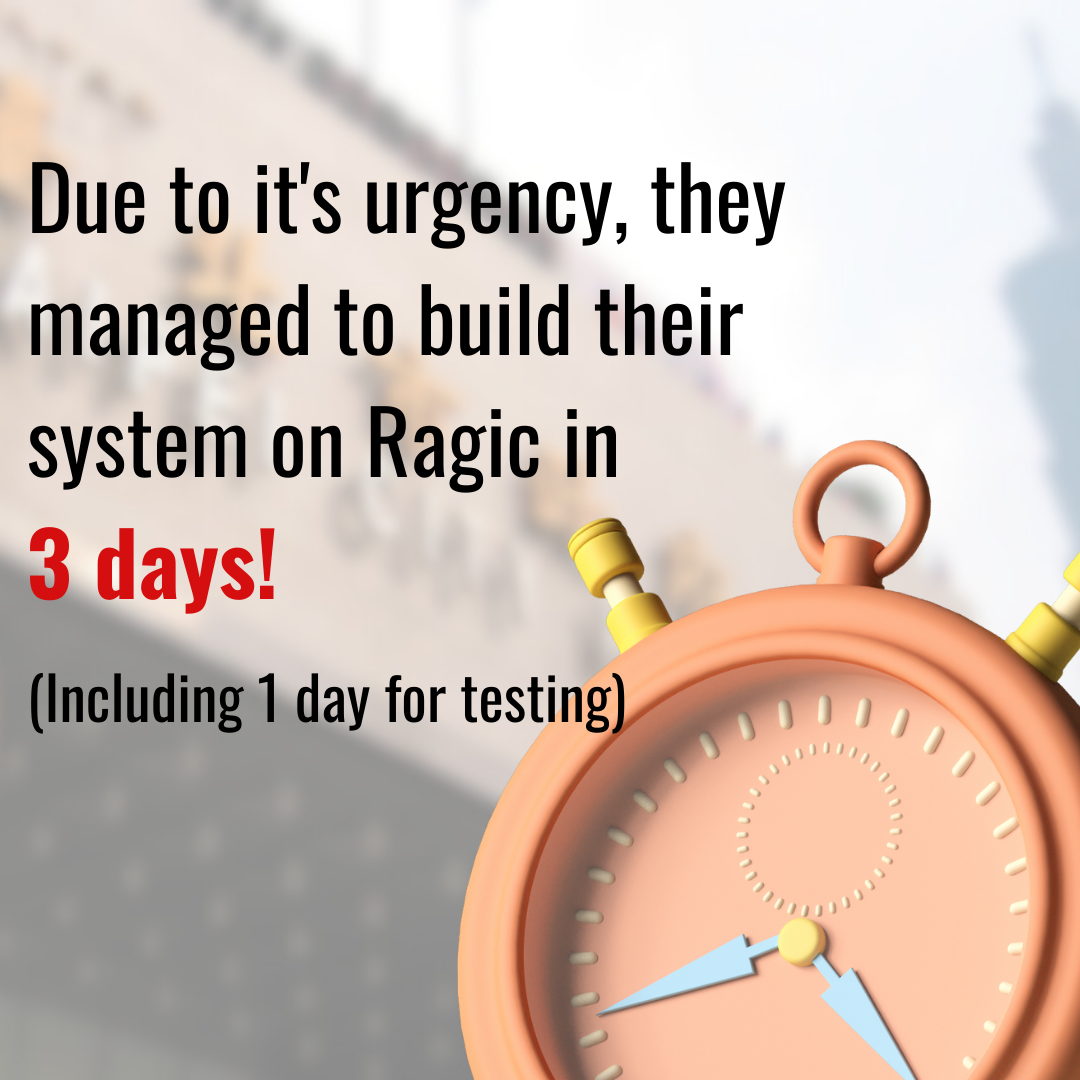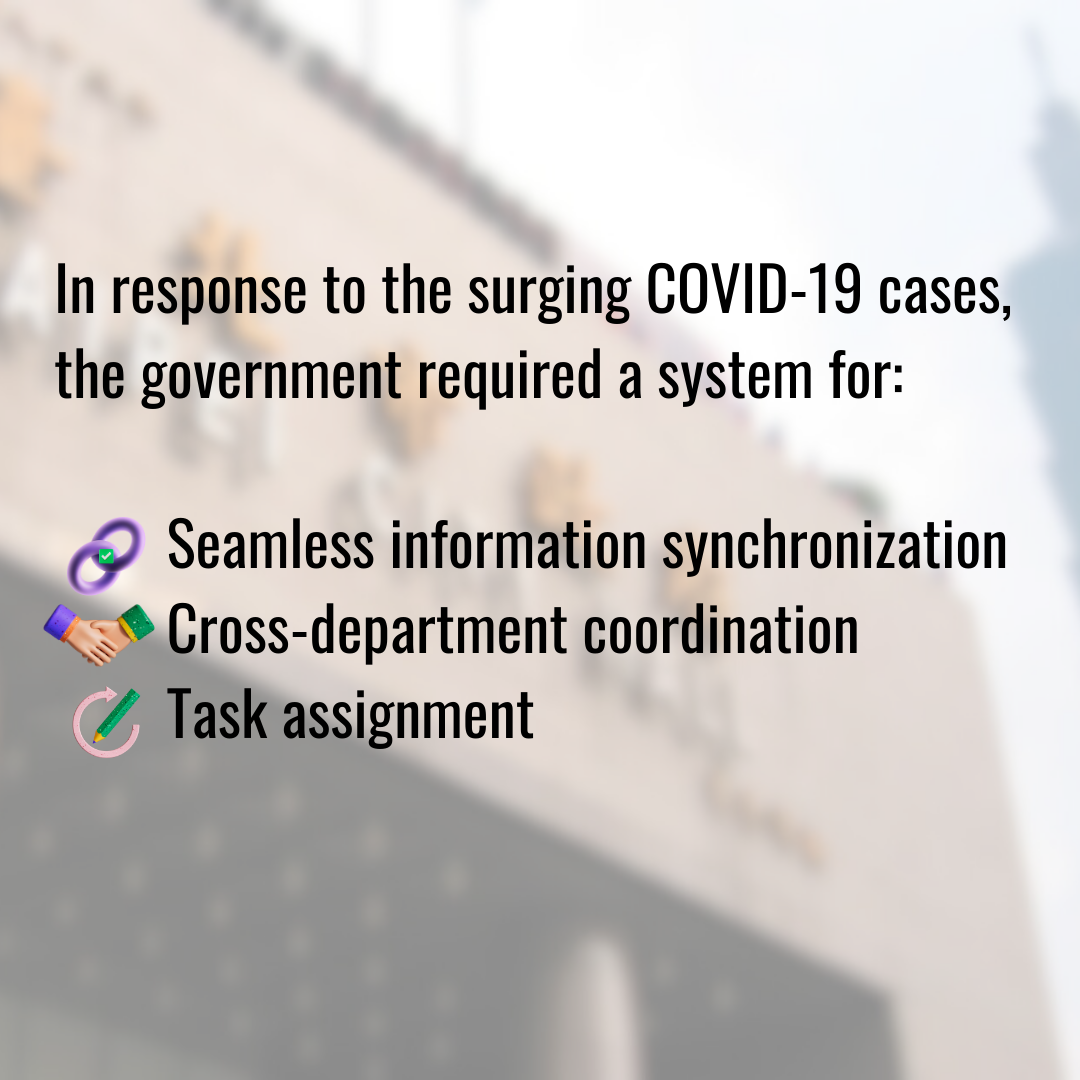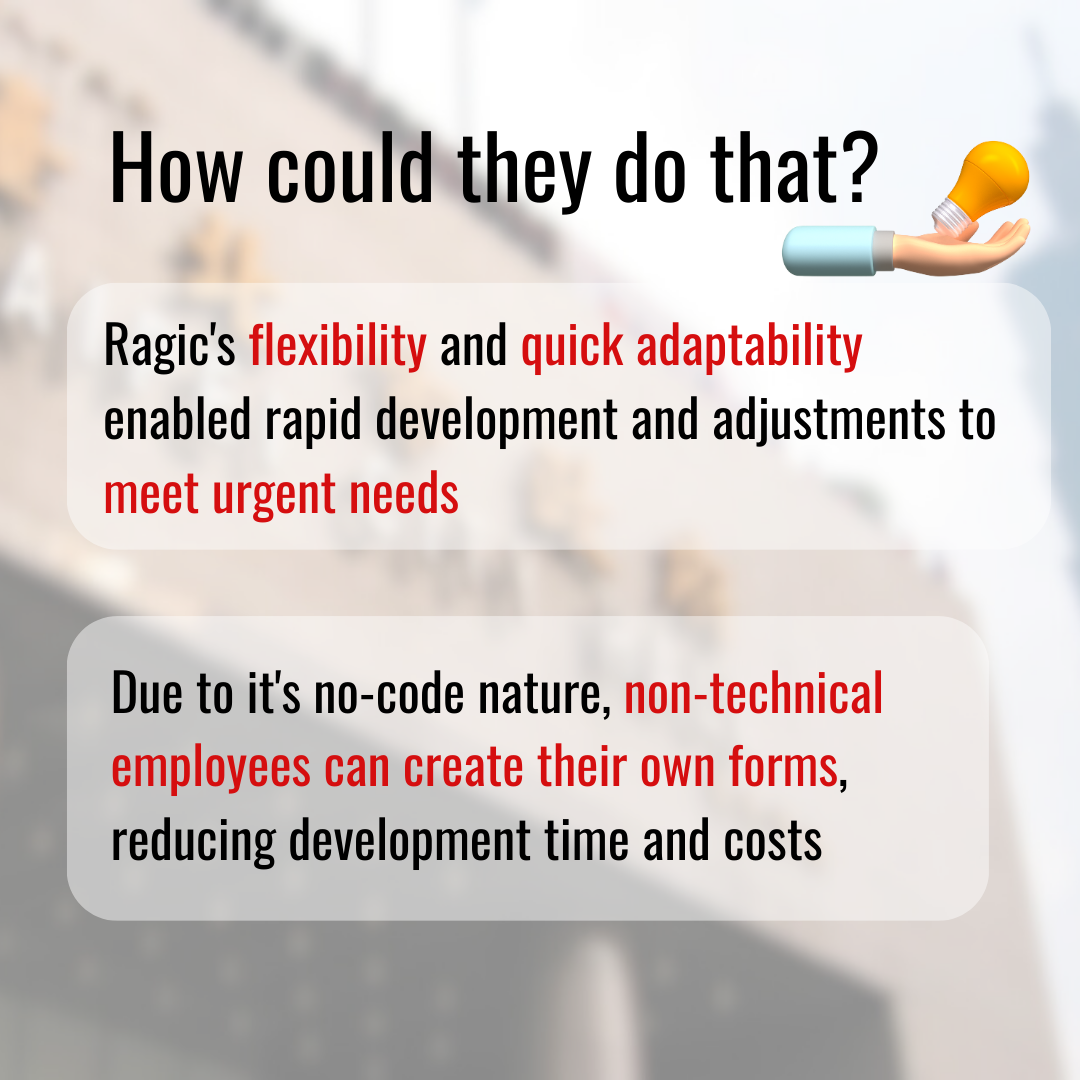Taipei City Government Slashed $2 Million USD in Costs With Ragic
| Organization Name | Department of Information Technology, Taipei City Government |
| Type | Government Agency |
| Benefits of Implementation | |
| Applications | |
| Subscription Plan | Enterprise Version (On-premise server) |
| Scale of Use | Cross-unit coordination with more than 2000 sheets |
Ragic's high adaptability has made it a top pick for government organizations worldwide, from managing prison inmate data to organizing geological surveys. One government entity that has implemented Ragic is the Department of Information Technology of Taipei City Government. As a government entity that navigates a spectrum of requirements, involving numerous employees, diverse workflows, and occasionally, urgent timeframes, Ragic stands as a dynamic solution for them to address their multifaceted database needs.
COVID-19 Prevention Task Allocation System Built in 3 Days

Looking back to the 15th of April, 2022, confirmed cases of COVID-19 in Taiwan surged at an unprecedented speed. In response to the imminent increase in the need for home care of confirmed cases, the then Taipei Mayor, Wenzhe Ke, announced the trial implementation of the "COVID-19 Prevention and Care System" in the Xinyi District, scheduled to launch just three days later. The center aimed to provide mild symptoms patients with three meals and proper garbage disposal services.
That announcement made the day unforgettable for the technical team in the Department of Information Technology. With the emergency order coming just a few hours before the afternoon press conference, they had to swiftly establish a system to cater to the requirements of all units for information synchronization, cross-departmental coordination, and task assignment for the operation of the COVID-19 Prevention and Care Center.
“It was Friday afternoon, and we were told that the system needs to be ready on Monday”
Meaning, counting the testing day as day one, they were left with just two days to build the system. Under normal circumstances, updating the list of confirmed cases and assigning them to different responsible units would take about two weeks with the standard process. However, due to the urgency of the pandemic, the technical team had to swiftly utilize the most immediate solution available and get to work.
That solution is the No-Code Ragic Cloud Database – which had been implemented by the Department of Information Technology, Taipei City Government for over a year. For those who aren't familiar with programming, this tool is a solution that allows even non-programmers to create their own database. But for professionals like the technical team of the Department of Information Technology of Taipei City Government, Ragic's capability for rapid development and flexible adjustments in response to changing demands made it a secret weapon in times of emergency.
The team managed to complete the first version of the system in 2 days. Due to its flexibility, as the COVID-19 Prevention and Care Center expanded its services to cover the entire Taipei Area, the system was also adjusted to accommodate the synchronization needs of various units. When the city mayor expressed that he wanted to see data analysis, the team was able to swiftly adjust and present the visualized information through a dashboard.
This COVID-19 Prevention Task Allocation System that was built in just three days is only one out of many successful implementations of Ragic in the Department of Information Technology of Taipei City Government. Over the past couple of years, they have built over 2,000 sheets in Ragic. In addition to reducing time and human labor while enhancing efficiency, they have managed to save an estimated budget of over $2 million USD through the implementation of Ragic.
Ragic for All Employees, Including Those With No Programming Background

Why did the Department of Information and Technology of the Taipei City Government opt for Ragic? Former Director Lin of the technical team revealed that the government had been actively seeking to digitize its operations. However, adhering to the conventional method of centralizing all related needs within the technical team led to a 'demand exceeding supply' scenario. As a result, they began seeking auxiliary tools to bridge this supply-demand gap.
Director Lin meticulously analyzed the government's requirements. In reality, the majority of these needs were relatively straightforward, such as data entry, collection, and basic processing. Hence, when the staff discovered that Ragic’s primary feature is its "spreadsheet-based interface," enabling employees without programming backgrounds to effortlessly grasp its usage – much like Word and Excel – and design uncomplicated sheets for their specific needs, it was an evident fit.
According to Director Lin, Ragic empowers the technical team to take a step back, enabling all employees who have a better understanding of the requirements to build their own sheets. This not only streamlines the process of constructing database systems by having those who understand their needs build them but also significantly saves time. Furthermore, this approach allows the technical team to allocate their efforts toward developing more intricate and technically-oriented projects. Ragic boasts impressive scalability, catering to a diverse array of applications.
A Full Cycle E-Audit System
The "E-Audit System" is the system established by the Department of Government Ethics of Taipei City Government, with assistance from the Department of Information Technology of Taipei City Government. This system empowers units within the Department of Government Ethics to construct their own sheets, approval flows, and reminders, tailored to their specific requirements, ultimately enhancing the efficiency of their auditing processes.
“Audit” refers to the fact that the Taipei City Government regularly dispatches staff to check whether various facilities of non-governmental organizations comply with fire safety inspections, building safety regulations, and business compliance guidelines. Currently, the city government conducts over 100 inspections on a regular basis, with 27 different units – such as the fire department, education bureau, and labor inspection office – depending on the project.
Before the city government implemented the E-Audit System, different units and audit projects maintained their separate processes, often lacking sufficient internal controls and reminders. Moreover, the initial hurdle of information collection during audits usually relied on paper-based methods. On-site auditors would fill out information manually, relying on handwritten audit forms signed by the responsible party on-site. Upon returning to the unit, these forms would be archived on paper or scanned as per the unit's procedures.
Director Lin highlighted several problems stemming from this paper-based approach. Firstly, the sole purpose of these paper documents is data retention, yet they inadvertently impose significant burdens due to the necessary archival period for audit records.
"All those papers take up space to store in the office. The Taipei City Government is located in the elite area of Xinyi District, can you imagine how much it adds to the additional costs for us for a year?"
Secondly, retrieving data when needed proves to be highly inefficient. To trace back information, one must sift through numerous sheets of the paper trail, often leading to frustration. Modifications or collaborations with other units are challenging to track, often causing miscommunication and workflow delays. Even with the previous “digitization” approach that fails to cover the whole workflow, it requires manual effort to repeatedly scan paper documents for system input. While it addresses the problem of inefficient data retrieval, it still demands a significant amount of manpower to repeatedly scan and input the data into the system, which isn't as seamless as electronically inputting data through a unified database.
The fire accident that happened in a KTV in Taipei City prompted the city government to accelerate the review of the lack of overall management, reminder mechanism, and cross-unit instant notification in the audit process. Last year, they began to build their new system with Ragic.

This new E-Audit System built with Ragic is focused on establishing a complete digitalization cycle. Every unit and all processes must be digitized, starting from the front lines of data collection. On-site auditors use the Ragic app to complete data collection sheets, including uploading scene photos for more comprehensive data.
Simplifying Workflow Digitization: Bridging Paper-To-Digital Gaps

The challenge in digitizing workflows often arises from the stark disparities between paper-based and digital processes. Off-the-shelf software systems typically deviate significantly from paper-based procedures, leading to customization challenges. However, Ragic, renowned for its high customizability, provides a solution. Those building the sheets can tailor them to match the familiarity of auditors or relevant staff. Furthermore, Ragic features a signature field that streamlines approvals, enabling easy sheet signing. Its robust customization seamlessly integrates with existing workflows, simplifying digitization while eliminating paper trail burdens.
Adjusting the Workflow According to Needs
Once the on-site auditors input the case details, the data is directly integrated into the system. Subsequent steps, including reviews, tracking, and case closures, predominantly take place within the Ragic platform. With 27 inspection units and over 100 audit functions under the government's umbrella, each unit operates with distinct internal control protocols and management practices to handle their respective responsibilities.
Conventional software solutions often involve programming professionals conducting individual interviews with users to ascertain requirements and construct corresponding systems. This approach can prove arduous, especially if miscommunications arise or the actual organizational context isn't fully considered, necessitating subsequent demanding adjustments.
However, Ragic adopts a different operational approach. The Department of Government Ethics of Taipei City Government takes the initiative to conduct training, imparting Ragic knowledge to future users across various units. They are educated on how to effectively use Ragic, design and modify sheets, and align them with their specific needs. This method empowers users to independently create their sheets and build their workflow, for example, setting up the required reminders, making adjustments remarkably straightforward, offering a high degree of flexibility.
Agriculture, Fishery, and Livestock Supply Information Dashboard
So, how can programmers aid governmental employees in enhancing work efficiency with a simpler, less labor-intensive approach? Here’s an example of how the technical team of the Department of Information Technology of Taipei City Government assisted the Department of Economic Development of Taipei City Government in creating the "Agriculture, Fishery, and Livestock Supply Dashboard"
The Taipei City Industrial Development Bureau has long been sharing the daily transaction volumes and wholesale prices of agricultural and livestock products on its website for public reference. However, up until last year, they still manually inspected and updated the whole data. Data was downloaded from the Open Data website, then meticulously organized into Word files, one after another, before being uploaded to the website.
This process faced several significant challenges. Firstly, it was incredibly time-consuming and labor-intensive. Each day, marketing staff needed to spend an hour or two sorting through this Word file. Moreover, the data captured and sorted were often managed by different contractors at different points in time, leading to inconsistent data benchmarks and less precise information presentation. Not to mention, data without visual representation was less accessible for public viewing.
The technical team devised an innovative solution using Ragic and an external reporting tool (PowerBI). They redesigned the process, automating it: the daily transaction prices, volume details, and other relevant information previously housed in Word files were restructured and placed within Ragic sheets. By harnessing Ragic's periodic import from the URL function, government-published CSV data pertinent to the market was automatically imported into Ragic each day. This information was then updated on the Taipei City Market website through API integration, creating the "Agricultural Products Wholesale Market Trading Information Dashboard".
This transition to an automated process eliminated the need for data sorting and comparing, saving an average of one hour per day. Simultaneously, as all data adhered to a fixed update schedule, discrepancies in out-of-sync information were eradicated.
To automate this process, the estimated cost was around $10,000 USD if executed through a formal bidding process, which typically takes at least two months due to administrative procedures. Including development time, three months might even be considered rushed. However, by leveraging Ragic, the technical team completed the task in less than a month without incurring any extra budget. This approach not only slashed development time but also circumvented the cumbersome government bidding procurement process.
A Total Budget Cut of Over $2 Million USD
COVID-19 Prevention Task Allocation System, E-Audit System, and Agricultural, Fishery, and Livestock Supply Information Dashboard are just a few of the many Ragic's applications by the Taipei City Government. Many of these forms are built by users themselves, with a total of more than 2,000 sheets.
Looking at all the sheets and systems currently built in Ragic, if the conventional method of bids and outsourcing were used, it would result in substantial establishment and maintenance costs due to individual bids and manufacturers to cater to the needs. Taking the E-Audit System as an example, which consolidates several older systems, the Taipei City Government estimates that developing this system conventionally would exceed $1,000 USD. Factoring in development for 27 units and five years of service maintenance, this projection climbs to over $1.5 million USD. With Ragic's fixed annual licensing fee deduction, the city government's savings exceed $2 million USD, providing substantial fiscal relief.
Apart from its demonstrated adaptability, which has been showcased through its adoption by governments worldwide to address diverse needs, Ragic also provides an on-premise version tailored for government entities that prioritize keeping their data in-house. Ragic's impact extends beyond streamlined processes; it paves the way for efficient and cost-effective administration, ensuring data security. This positions Ragic as a valuable tool in modern governance.
Categoría: Case Studies > Government



